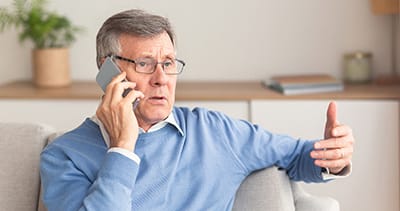As winter weather falls upon us, many of us may feel like we could hibernate until Springtime. Instead, the best many can hope for is a good night’s sleep. In the winter, several challenges may impede our ability to get the most out of our recommended sleep requirements, including decreased opportunities for outdoor activity.
According to the Australian Drug Foundation and the USFDA, several other common factors can contribute to impaired sleep (2008; 2013):
- Stress
- Light and noise
- Napping after 3pm
- Exercising before bed
- Eating (especially sugary or caffeinated foods) or drinking alcohol before bed
- Keeping an inconsistent sleep schedule (for example, going to bed and waking up at different times during the week)
Unusually irritable? Can’t focus? Feeling more depressed? Poor sleep may be the culprit.
While some of us can function well on fewer hours of sleep, getting insufficient or poor-quality sleep can affect many aspects of our lives (National Institute of Health, 2016). Here are several ways poor sleep habits can impact your wellbeing:
- Drowsiness
- Inability to think clearly
- Increased anxiety
- Increased likelihood of depression
- Increased risk of diabetes and obesity
- Increased risk of high blood pressure and heart disease
- Decreased reaction time and handeye coordination (research indicates moderate sleep deprivation can impair a person’s driving ability equivalent to, or worse than, driving while intoxicated with alcohol) (Williamson & Feyer, 2000)
How can you combat the effects of poor sleep habits?
Here are some tips to ensure you get the most out of your rest.
What’s the magic number for when to unplug your phone before bed?
A recent study from the Lighting Research Center indicates you need to log off and shut down your devices 2 hours before you sleep (2018). While binge watching your favourite programs on your computer or phone may seem like a great way to unwind, doing so before bed is shown to be detrimental to our brain’s ability to transition into “night mode.” The bright, blue light from our phones, tablets, and computers keeps our brains in a heightened state of wakefulness, making it harder to fall asleep and decreasing sleep quality. Some people have difficulty putting down their phones at all. If you must use your devices at night, lower the brightness settings to a minimum level. Consider setting up alarms or notifications on your device before bed to let you know when you should be shutting down yourself and your devices.
Develop a sleep ritual
Consistency is key to getting a good night’s sleep. Most people have a morning routine when they wake up. Consider adding a nighttime routine to wind down. Create an environment conducive to sleep by having your television, computers, and phones in another room. Make sure your room is dark and the temperature is comfortable for you. Before bed, do something relaxing, such as taking a bath, reading, or listening to music. If possible when you wake up, jumpstart your body’s circadian rhythm by getting into the sun for a few minutes. You can also place your alarm clock or phone across the room, so you must get out of bed to shut it off.
Let your body unwind: 4-2-4-2 breathing and muscle relaxation
To help you relax your body before bed, you can try these two techniques:
The first is a simple breathing exercise. You can do this lying down or sitting in a comfortable position. The best way to start is to put your hand on your belly. You want to make sure your air is expanding from your midsection, instead of “up” through your chest and shoulders. This is crucial to the exercise because it allows your body to breathe as if it is at rest — when you are relaxed, you naturally breathe “from your belly”. Your hand should rise and fall as you breathe in and out. Try to focus solely on your breath rather than your surroundings or any other thoughts you may be having. For the timing,
- breathe in for 4 seconds,
- hold your breath for 2 seconds,
- breathe out in a controlled manner over 4 seconds,
- wait 2 seconds before starting again,
- then repeat.
After about thirty seconds to a minute, you should feel calm. You can practice this during the day as a mental break for about a minute at a time as well.
The second technique is progressive muscle relaxation. During the day, many of us can ignore the tension carried in our bodies. When we lie down to sleep, muscle stiffness may still be there. This exercise allows us to understand where our bodies carry that tension and ease it. The exercise works by tensing each muscle group for about 5 seconds, quickly releasing that tension, then moving on to the next group after resting for 10 seconds. Do not strain your muscles by tensing them to the point of pain, just enough to tighten the muscles. Start in a comfortable seated or lying position. Begin with your feet and slowly work your way up your body, tensing and relaxing every muscle group in your body — your calves, your thighs, etc. up to your face, your brows and your forehead. Some people like to imagine their bodies sinking or melting into the bed or chair when they relax their muscles. Allow yourself 10 seconds in between tensing groups to focus on your body letting go of the day’s tension.
When is it time to get help with sleep?
If you have had difficulty sleeping nightly for more than two weeks, talk with your doctor or visit a sleep clinic. Insomnia, the inability to fall or remain asleep, is best treated with Cognitive Behavioural Therapy through a mental health professional. Your doctor or a sleep specialist may also prescribe medications for short term relief. Sleep apnea occurs when your breathing is interrupted multiple times throughout the night, causing chronic fatigue. It is often accompanied with loud snoring or choking sounds while you sleep. Untreated sleep apnea not only makes some people feel more tired and irritable, it can increase health risks such as high blood pressure, strokes, and heart attacks. Mild symptoms may be diminished with weight loss, avoiding alcohol and medicines that make you sleepy, and sleeping on your side. More severe cases often require a CPAP (Continuous Positive Airway Pressure) machine to be worn while sleeping.
References
Australian Drug Foundation. (2008). Getting a good night’s sleep without medication [Pamphlet]. Victoria, Australia: DrugInfo Clearinghouse
Lightning Research Center. (2018, February 5). New LRC study evaluates the effectiveness of Apple’s iPad Night Shift application [Press release]. Retrieved from https://www.lrc.rpi.edu/resources/newsroom/pr_story.asp?id=383#.XC0OBlxKhPb
National Institute of Health. (2016). How is the body affected by sleep deprivation? Retrieved from https://www.nichd.nih.gov/health/topics/sleep/conditioninfo/sleep-deprivation
United States Food and Drug Administration. (2013). Sleep problems [Pamphlet]. United States of America: Office of Women’s Health
Williamson, A. M., & Feyer, A. M. (2000). “Moderate sleep deprivation produces impairments in cognitive and motor performance equivalent to legally prescribed levels of alcohol intoxication.” Occupational and Environmental Medicine, 57(10), 649-655.





